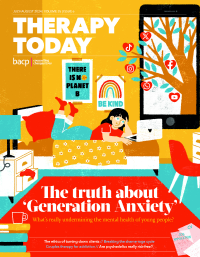During my therapist training, I kept putting off the requirement to go into personal therapy. Growing up in a traditional Punjabi household, we never openly shared emotions. Feelings were never discussed or talked about, and there is a belief in many Asian cultures that persistence and hard work can resolve any kind of problem, and that pretending something isn’t happening will make it go away. As I grew up I became an expert at suppressing my emotions. I still had feelings but I turned to writing poems and stories rather than talking as a way of coping when things felt overwhelming.
I started therapy training after being bullied in a corporate work environment. Looking back I can see I was drawn to the training as a way of understanding what had happened and why it had affected me so much. At the time I told myself I was doing it as it seemed to offer a more flexible career.
Even though I now know I was traumatised and struggling, I saw the requirement to have therapy during my training as a tickbox exercise. I spoke to four therapists before I found one who I felt comfortable with. As we got started I would dread the day I had personal therapy, thinking to myself, ‘What am I going to talk about?’ The session would feel so slow. I had always been more of a listener than a talker, and found a whole hour talking about myself very difficult.
The therapist was young and white but that wasn’t the problem – I don’t think I would have opened up my feelings to an Asian therapist either. She was very patient and made the space feel welcoming, not rushing me but just going at my pace. Then in my sixth session I broke down and began to cry. It all came out – I was a mum, I was studying, I was working, I was juggling so many plates that I didn’t know if I was coming or going. Experiencing that release in the therapeutic space created a shift in my mindset, like a breath of fresh air.
Slowly I began to trust that anything I shared in the room was confidential and that I wouldn’t be judged or shamed for expressing my feelings or emotions. I was able to explore the challenges in my relationship, my traumatic birth experiences, my grief at losing my mum to cancer and being bullied at work.
I hadn’t realised that I had suppressed so many emotions, and that I had not processed or acknowledged the traumas that I had gone through. I was holding my feelings as a heaviness in my body. I became aware of how easily interactions with people could trigger me into a low mood, and I could finally admit to myself how anxious I felt a lot of the time, and that I had panic attacks.
By acknowledging and exploring the heaviness I was carrying, it began to move and no longer felt stuck inside me. The more I talked, the lighter I felt. I had many light-bulb moments, seeing patterns and connections that helped me understand my responses to present situations.
Now I am qualified and working as a therapist, and I feel like I’ve come full circle by also returning to my childhood passion of writing. This time, however, it’s not for my own survival – it’s to help others find their own journey of inner healing and, like me, to discover their own strength.

